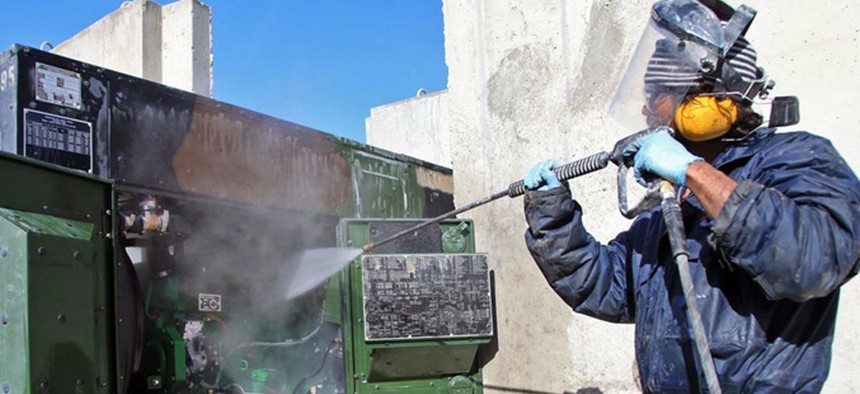Here’s What the New Tesla Battery Means for the Military

A private contractor sprays water to clean parts of a generator at Forward Operating Base Shank, Logar province, Afghanistan, March 14, 2012. Defense imagery management operations center
Elon Musk’s big announcement could revolutionize energy use for U.S. consumers—and that could be its biggest effect on national security.
Last week, Silicon Valley superstar Elon Musk announced the release of the Tesla Powerwall home battery to the rapturous delight of tech journalists and Musk-o-philes everywhere. On offer: a 7-kilowatt energy storage device for $3,000 and a 10-kilowatt unit for $3,500.
Now industry watchers are debating whether the Powerwall, which is made to store electricity when it’s cheap and release it when it’s costly, is inexpensive enough to disrupt consumer energy markets. But it’s certainly cheap enough for military buyers. Would it be useful?
Futurist and energy watcher Ramez Naam compared the electricity delivered by Powerwall to the stuff that comes out of your average power outlet. He found that the battery could deliver a kilowatt-hour for 35 cents.
“That compares to average grid electricity prices in the USof 12 cents/kWh, and peak California prices on a time-of-use plan of around 28 cents/kWh,” he wrote.
But when the battery is paired with a renewable, carbon-neutral energy source like wind or solar, it’s potentially much better for the environment. Naam later calculated that the numbers become much more attractive for the Powerwall over a decade’s use, if the battery can live up to warranty claims.
The calculus is different for the military, particularly for ground units that don’t have to worry about going off the grid…because they’re already there, operating from remote bases in places like Afghanistan.
Forward operating bases, often staffed by the most elite fighters that any nation ever produced, represent the spear tip of American foreign policy. During U.S.-led operations in Afghanistan, getting generator fuel to those bases was no easy or safe affair. In 2011, a Marine Corps report noted that the service was operating more than 100 forward bases, each of which consumed at least 300 gallons of diesel fuel daily — for a whopping total of more than 200,000 gallons of fuel every day. Most of that was trucked in overland, at great cost in time, money, and resources, and at great risk to troops and civilian contractors.
“According to U.S. Transportation Command (USTRANSCOM), ground convoys were attacked 1,100 times in 2010-12, and that may not count movements of fuel at the tactical level, from forward operating bases to patrol bases,” another 2011 DoD document said. “In addition to these attacks, the terrain, weather, and political concerns also have been a challenge for supply lines.”
Keenly interested in better ways to supply electricity to forward bases, the Marine Corps in 2009 created the Marine Expeditionary Energy Office. The following year, the Army Capabilities Integration Center, or ArCIC, studied the issue.
Paul Roege, a retired Army colonel, helped write ArCIC’s 2010 report on the matter, which recommended turning away from diesel to alternative energy sources, batteries and storage devices. He found, among other things, that most forward bases were small — 80 percent of the soldiers and Marines in Afghanistan operated from just 14 percent of the bases — and were good targets for replacement of noisy, fuel-thirsty, manpower-intensive diesel generators with reasonably-sized solar arrays.
Ted Vogel, president of the company 12 South, analyzed power efficiencies at forward operating bases in Afghanistan for U.S. Central Command in 2011 and 2012. He found that the diesel generators on many bases were far larger than necessary. Many generators produced 55 MW, but were constantly operating well below capacity, at 19 MW or so.
“The military perspective on energy is this: you took three times more stuff than you needed,” he told Defense One.
That’s a lot of wasted money, and a lot of supply troops put needlessly at risk, Vogel said. Even under an optimally configured power structure, Vogel said, it costs $1.74 to produce a kilowatt-hour using diesel generators on a forward operating base.
So, he said, “In a military sense, [the Powerwall] is something that definitely makes sense.”
He cautioned, however, that Elon Musk’s new product is no silver-bullet solution. In its largest configuration, a constellation of consumer-grade Powerwalls can store no more than 90 kilowatts. He proposes a solution where “microgrids” of batteries within bases reduce overall energy consumption, which is also something the Pentagon has been exploring for some time.
But Tesla has something that most other alt-energy players don’t: the resources to redesign their big battery pack to military specifications—for example, making it more rugged and less vulnerable to electronic warfare. Vogel estimated the cost of redesigning a completed consumer product, like a battery, at $200,000 to $400,000.
The Powerwall stores power made somewhere else. Much of the excitement surrounding the the big battery is because it promises to allow homeowners to use a lot more of the electricity generated by solar panels. Roege cautioned that won’t work for extremely large forward operating bases.
“Forward operating bases require security, which means the physical footprint is an important consideration,” he told Defense One. He says that a military base that requires 5 megawatts of power would need about 66 acres of photovoltaic panels.
“Delivering those solar panels would take more effort than three years’ worth of diesel fuel,” he said.
For the far more common small forward operating base, the story is different. “In the end, I’d say that Powerwall could be very useful for distributed users – small combat outposts and key infrastructure nodes,” he said.






